Gram Positive Bacteria
Gram Positive Bacteria-
The Gram-Positive bacteria take the Crystal violet stain used in the test, and then appear to be purple-colour when seen through an optical microscope.
- Staphylococci
- Streptococci
- Diplococcus pneumonia
- Bacillus Anthracis
- Coryne-bacterium Diphtheriae
- Clostridia
1. Staphylococci-
General Characters
- They are Gram positive cocci, which are normally arranged in clusters but under special conditions may also occur singly, in pairs or in short chains.
- They are non-motile, non-sporing and non-capsulated.
- They grow easily in ordinary culture media (nutrient agar).
- They are facultative aerobic but a few are strictly anaerobic.
- The infection occurs through human patients or carriers.
- They are transmitted by direct contact, through contaminated fomites or through air borne droplets.
The following two types of staphylococci are identified-
a. Staphylococcus aureus (S. pyogenes)-
They produce golden yellow colonies on the skin. Main sources of infection are human patients or carriers. They have many portals of entry and exit, and are able to infect any part of the body. These organisms cause the majority of the pyogenic infections in human being, and are very common in hospitals.
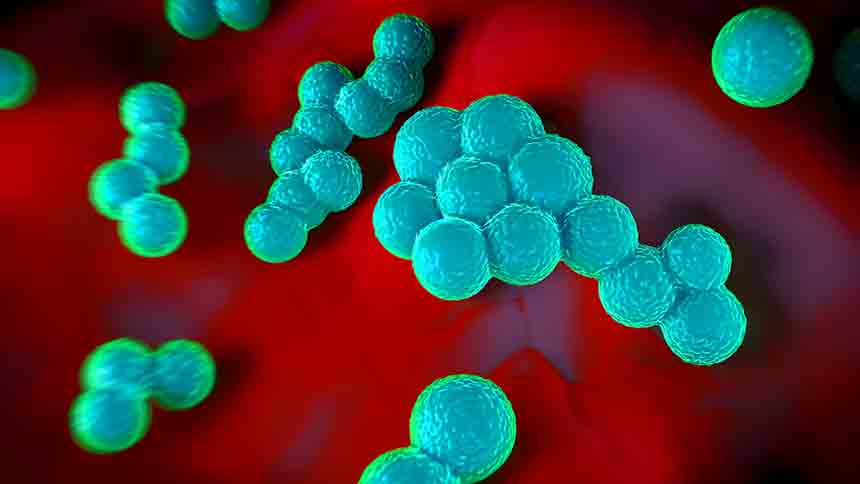
The diseases caused by S. aureus are classified as-
- Cutaneous Infections- The cutaneous lesions include pimples, abscesses, boils, carbuncles, sepsis in wound and burns.
- Deep Infections-
- Osteomyelitis
- Mediastinitis
- Peritonitis
- Meningitis, Subduralempyema,
- Abscesse formation in all parenchymal
3. Food Poisoning- These cocci grow in meat, fish, milk, milk products and precooked food. They produce an enterotoxin which, when swallowed, causes nausea, vomiting and diarrhoea. The enterotoxin is highly resistant to heat.
b. Staphylococcus albus-
They are widely distributed on the bodies of human beings, and produce white pigments on the skin. They are normally non-pathogenic and form a part of the skin flora, but, if the skin is injured, the cocci can get into the tissues and cause infection. Stitch abscesses are mostly caused by these organisms. Abscesses may even lead to septicaemia.
Bacteriological Investigations-
Examination of pus, faeces, swabs from infected areas, nasal swabs of carriers, sputum from respiratory infection, etc.
2. Streptococci-
General Characters
- They are Gram positive cocci, which occur in short or long chains.
- They are non-motile, non-sporing and non-capsulated.
- They require special substances in culture media, such as blood or serum, for growth.
- They may be facultative, aerobic or anaerobic.
- Infection occurs from patients and transmission is through skin, vagina and throat.
- They are the most important of all pyogenic organisms with a characteristic tendency to spread.
- Except for the non-pathogenic species, such as S. lactis, which grows in milk and milk products, the streptococci are parasites of human being and animals.
Streptococci, on the basis of their action on red blood corpuscles in blood-agar medium, are distinguished into three types namely
- Alpha
- Beta
- Gamma
Alpha Type-
These produce greenish area around the colony with or without an outer clear colourless area. They are generally present in throat. They produce less acute infections than beta type. Rarely they cause infection in teeth and heart valves.
Beta Type -
They produce a clear colourless zone around their colonies, which is known as beta type haemolysis. One of the well-known examples of beta type is Streptococcus pyogenes.
The diseases caused by Streptococcus pyogenes are classified as:
- Respiratory Infections: Sore throat is the commonest of all infections, and it may cause tonsilitis, pharyngitis and bronchopneumonia. The infection may also spread to surrounding tissue.
- Skin Infections- It may cause infection in wounds and burns, and may lead to septicaemia.
- Puerperal Infection- Streptococci are normal inhabitants of the genitalia in women. It may cause puerperal infection after delivery. This infection is also called puerperal fever.
- Other Infection- S. pyogenes can also cause infections like abscesses in internal organs, such as brain, lung, liver and kidney; rheumatic fever and even fatal septicaemia.
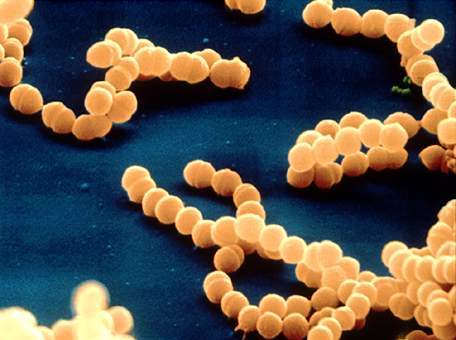
Gamma Type -
Streptococcus faecalis (enterococcus) belongs to this type. These organisms generally
3. Diplococcus pneumoniae (Pneumococcus)
General Characters
- They are Gram positive cocci occurring in pairs, and often in short chains.
- They are non-motile, non-sporing, and capsulated, each capsule encloses one pair.
- They require blood media for growth.
- They may be aerobic or facultative anaerobic.
- On blood-agar they form granular colonies surrounded by green colour.
- They are readily killed by heat and chemicals.
- They may infect bronchi or one or more lobes of lung and cause pneumonia. They may also cause meningitis, peritonitis, conjunctivitis, etc.
- Transmission is through direct contact or inhalation of droplets expelled during coughing, sneezing or by objects freshly contaminated with respiratory secretions.

Bacteriological Investigation- Examination of sputum in pneumonia; cerebrospinal fluid in meningitis; pus and swabs in pyogenic infections.
4. Corynebacterium Diphtheriae (Diphtheria Bacillus)-
These were discovered by two German physicians, Klebs and Loeffler, so they are also called as Klebs-Loeffler or ‘K-L’ bacilli.
General Characters
- They are Gram positive bacilli, arranged in V or L shape (chinese letter pattern).
- They are non-motile, non-sporing and non-capsulated.
- They require special substances, e.g., blood or serum in media for growth.
- They are strictly aerobic.
- Granules are present at the poles which can be stained with Albert Stain.
- These organisms localise in the throat, tonsils and nose, cause inflammation, give off a powerful exotoxin, which irritates the tissue and produces pseudomembrane in the throat. The membrane slowly extends into the entire respiratory tract. If the patient is not treated in time, the membrane may block the respiratory passage, cause suffocation, and complications, such as, asphyxia, cardiac failure (due to the destruction of heart muscles) and pneumonia. This disease can be prevented by a programme of mass immunization with diphtheria toxoids in various doses during infancy.

Bacteriological Investigation- Examination of swabs from tonsils, lesions and from nose in carriers. When confirmed for diphtheria, an antitoxin is given along with antibiotics to control the disease.
5. Clostridia-
Clostridia are a species of soil-dwelling anaerobic bacteria that produce toxins that can kill a host in a short period of time.
General Characters-
- They are Gram positive bacilli found singly, pairred or in long chains.
- They are mostly motile with peritrichate flagella; some are non-motile; either capsulated or non-capsulated. They are spore bearing; spores may be situated terminally, sub-terminally or centrally.
- They grow in ordinary media and are strictly anaerobic.
- They produce powerful exotoxin.
- Infection/intoxication occurs through spores, soil, faeces or preserved food.
- They are transmitted by direct contact with contaminated objects or animal faeces or poisoned tinned food.
- Clostridium species are mostly harmless and saprophytic; some are pathogenic.
Even pathogenic members may not cause disease unless the organisms or spores are carried into wounds or tissues, where conditions are suitable for growth and toxin production.
The genus Clostridium includes three important pathogenic species
- Clostridium tetani
- Clostridium perfringens
- Clostridium botulinum
1.Clostridium tetani-
It causes tetanus. It is non-capsulated with round terminal spores. Its spores enter through skin or wound, secrete toxin, which is absorbed by the wound and poisons the anterior horn cells of the spinal cord affecting the motor nerves and resulting in tetanus disease. It is prevented by immunisation with tetanus toxoid during infancy. When the disease is confirmed, it is controlled by tetanus antitoxin injection.

2. Clostridium perfringens (C. welechi)-
It causes gas gangrene. These organisms are brick shaped, capsulated and produce toxin. The toxin enters the wound and attacks muscles with damaged blood supply producing the disease gas gangrene.
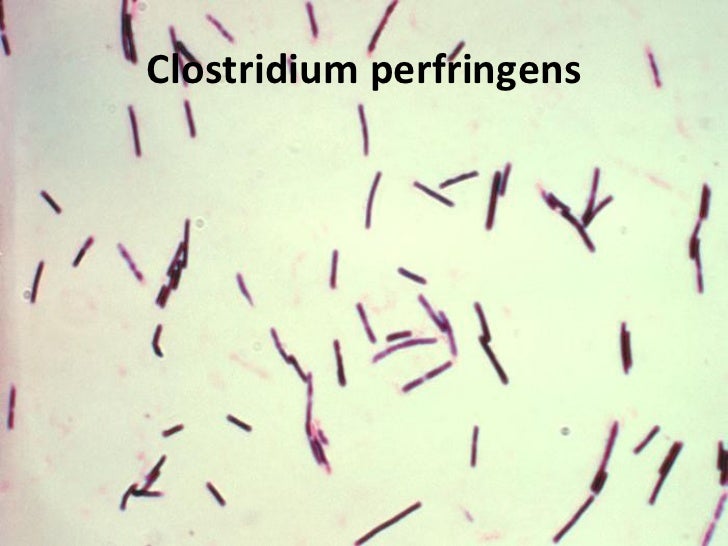
3. Clostridium botulinum-
It causes botulism (food poisoning). Its subterminal spores are wider than the vegetative cells. It is non-capsulated, and produces toxin in tinned or semi-cooked food, which when eaten causes acute toxaemia, characterised by paralysis of nerves and diaphragm, and food poisoning. It can be prevented by proper preservation of food.
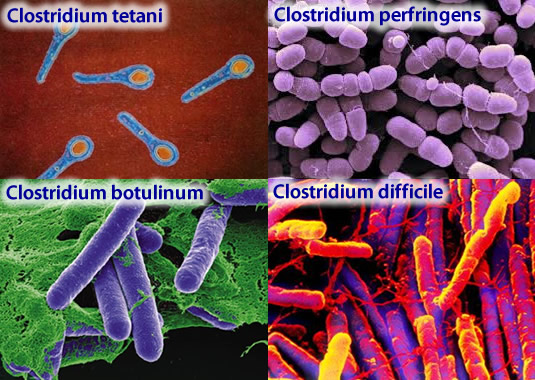
6. Bacillus anthracis (Anthrax bacillus)
General Characteristics-
- They are Gram positive bacilli, found singly, in pairs or in chains
- They are non-motile (all other species are non-pathogenic and motile), spore-bearing and capsulated (entire chain may be surrounded by capsule).
- They grow in ordinary media and are aerobic.
- The organism causes anthrax disease, which is primarily a disease of cattle, sheep and pigs. This disease is commonly present in workers handling wool and hides of animals affected with anthrax disease. Man contracts this disease from animals directly or indirectly.
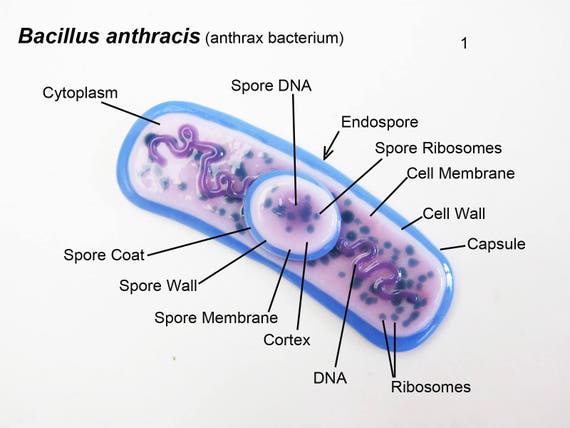
In human being anthrax occurs in three forms-
- Cutaneous anthrax- Its germs enter through cut or abrasions in the skin or hair follicles, and an ulcer is formed, which gives rise to gangrene. In severe cases it may lead to septicaemia.
- Pulmonary anthrax- It occurs due to inhalation of dust (containing spores) from infected wool.
- Intestinal anthrax- It occurs very rarely. It is caused due to ingestion of cooked or partly cooked meat. It leads to bloody diarrhoea and unless treated in time, it is fatal.
Bacteriological Investigations- Examination of infected tissue or swabs.